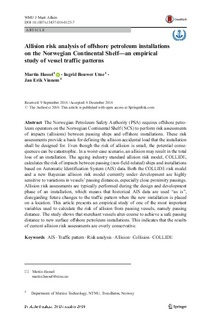| dc.contributor.author | Hassel, Martin | |
| dc.contributor.author | Utne, Ingrid Bouwer | |
| dc.contributor.author | Vinnem, Jan Erik | |
| dc.date.accessioned | 2017-10-27T10:42:05Z | |
| dc.date.available | 2017-10-27T10:42:05Z | |
| dc.date.created | 2017-01-17T10:02:01Z | |
| dc.date.issued | 2017 | |
| dc.identifier.citation | WMU Journal of Maritime Affairs (JoMA). 2017, 16 (2), 175-195. | nb_NO |
| dc.identifier.issn | 1651-436X | |
| dc.identifier.uri | http://hdl.handle.net/11250/2462558 | |
| dc.description.abstract | The Norwegian Petroleum Safety Authority (PSA) requires offshore petroleum operators on the Norwegian Continental Shelf (NCS) to perform risk assessments of impacts (allisions) between passing ships and offshore installations. These risk assessments provide a basis for defining the allision accidental load that the installation shall be designed for. Even though the risk of allision is small, the potential consequences can be catastrophic. In a worst-case scenario, an allision may result in the total loss of an installation. The ageing industry standard allision risk model, COLLIDE, calculates the risk of impacts between passing (non-field-related) ships and installations based on Automatic Identification System (AIS) data. Both the COLLIDE risk model and a new Bayesian allision risk model currently under development are highly sensitive to variations in vessels’ passing distances, especially close proximity passings. Allision risk assessments are typically performed during the design and development phase of an installation, which means that historical AIS data are used “as is”, disregarding future changes to the traffic pattern when the new installation is placed on a location. This article presents an empirical study of one of the most important variables used to calculate the risk of allision from passing vessels, namely passing distance. The study shows that merchant vessels alter course to achieve a safe passing distance to new surface offshore petroleum installations. This indicates that the results of current allision risk assessments are overly conservative. | nb_NO |
| dc.language.iso | eng | nb_NO |
| dc.publisher | Springer Verlag | nb_NO |
| dc.rights | Navngivelse 4.0 Internasjonal | * |
| dc.rights.uri | http://creativecommons.org/licenses/by/4.0/deed.no | * |
| dc.title | Allision risk analysis of offshore petroleum installations on the Norwegian Continental Shelf—an empirical study of vessel traffic patterns | nb_NO |
| dc.type | Journal article | nb_NO |
| dc.type | Peer reviewed | nb_NO |
| dc.description.version | publishedVersion | nb_NO |
| dc.source.pagenumber | 175-195 | nb_NO |
| dc.source.volume | 16 | nb_NO |
| dc.source.journal | WMU Journal of Maritime Affairs (JoMA) | nb_NO |
| dc.source.issue | 2 | nb_NO |
| dc.identifier.doi | 10.1007/s13437-016-0123-7 | |
| dc.identifier.cristin | 1429273 | |
| dc.description.localcode | © The Author(s) 2016. This article is distributed under the terms of the Creative Commons Attribution 4.0 International License (http://creativecommons.org/licenses/by/4.0/) | nb_NO |
| cristin.unitcode | 194,64,20,0 | |
| cristin.unitname | Institutt for marin teknikk | |
| cristin.ispublished | true | |
| cristin.fulltext | original | |
| cristin.qualitycode | 1 | |

